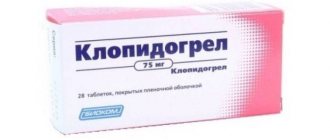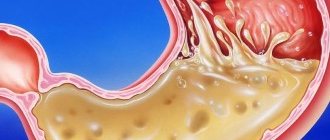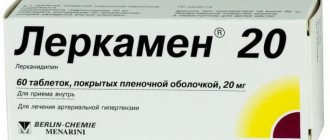Lopirel
Active substance:
Clopidogrel*
Pharmgroup:
Antiplatelet agents
Average price in pharmacies
| Name | Manufacturer | average price |
| Lopirel 0.075 n28 tablet p/film casings | Actavis Ltd | 732.95 |
Analogs for the active substance:Aggregal Deplatt-75 Detromb Sylt Cardutol Clopigrant Clopidogrel Clopidogrel-LEKSVM Clopidogrel-Teva Clopidogrel hydrosulfate Clopidogrel bisulfate Clopyletes Listab 75 Plavix Plagril Plogrel Targetek Trocken Aegitromb |
Instructions:
Clinical and pharmacological group
20.028 (Antiplatelet agent)
Release form, composition and packaging
The tablets are pink, round, biconvex, film-coated, with an “I” engraved on one side.
| 1 tab. | |
| clopidogrel hydrogen sulfate | 97.87 mg, |
| which is equivalent to the content of clopidogrel base | 75 mg |
Excipients: lactose - 78.13 mg, microcrystalline cellulose - 68.75 mg, crospovidone (type A) - 13.75 mg, glyceryl dibehenate - 8.25 mg, talc - 8.25 mg, Opadry II 85 G34669 pink ~ 8.25 mg (polyvinyl alcohol - 3.63 mg, talc - 1.65 mg, titanium dioxide (E171) - 1.63 mg, macrogol 3350 - 1.02 mg, lecithin (E322) - 0.29 mg, red iron oxide dye (E172) - 0.03 mg).
7 pcs. - blisters (4) - cardboard packs. 10 pcs. - blisters (9) - cardboard packs.
pharmachologic effect
Antiplatelet drug, a specific and active inhibitor of platelet aggregation. Has a coronary dilation effect. Selectively reduces the binding of ADP to platelet receptors and the activation of GPI Ib/IIIa receptors under the influence of ADP, thereby reducing platelet aggregation. Reduces platelet aggregation caused by other agonists, preventing their activation by released ADP, does not affect PDE activity. Irreversibly binds to platelet ADP receptors, which remain resistant to ADP stimulation throughout the life cycle (about 7 days).
Inhibition of platelet aggregation is observed 2 hours after administration (40% inhibition) of the initial dose of 400 mg. The maximum effect (60% suppression of aggregation) develops after 4-7 days of continuous use at a dose of 50-100 mg/day. The antiplatelet effect lasts throughout the life of platelets (7-10 days).
In the presence of atherosclerotic lesions of the vessel, it prevents the development of atherothrombosis, regardless of the localization of the vascular process (cerebrovascular, cardiovascular or peripheral lesions).
Pharmacokinetics
Suction
Absorption is high, bioavailability is high; the plasma concentration is low and 2 hours after administration does not reach the measurement limit (0.025 μg/l).
Distribution
Plasma protein binding is 94-98%.
Metabolism
Metabolized in the liver. The main metabolite is an inactive derivative of carboxylic acid. After oral administration in repeated doses of 75 mg, the Cmax of the metabolite in the blood plasma is about 3 mg/l and is achieved after 1 hour.
Removal
Excreted by the kidneys - 50%, through the intestines - 46% (within 120 hours after administration). T1/2 of the main metabolite after a single and repeated dose is 8 hours. The concentration of metabolites excreted by the kidneys is 50%.
Pharmacokinetics in special clinical situations
After taking the drug at a dose of 75 mg/day, the concentration of the main metabolite in plasma is lower in patients with severe kidney disease (creatinine clearance 5-15 ml/min) compared to patients with moderate kidney disease (creatinine clearance 30 to 60 ml/min) and healthy individuals.
Dosage
The drug is taken orally, regardless of food intake.
For patients who have suffered a myocardial infarction, ischemic stroke, or with diagnosed peripheral arterial disease, the drug is prescribed 75 mg 1 time / day. Treatment should begin from the first days to 35 days in patients after myocardial infarction and from 7 days to 6 months in patients after ischemic stroke.
In acute coronary syndrome without ST segment elevation (unstable angina, myocardial infarction without a Q wave on the ECG), including patients who have undergone stenting during percutaneous coronary intervention, treatment with Lopirel should be started with a single dose of 300 mg loading dose, and then continued in dose of 75 mg 1 time / day (in combination with acetylsalicylic acid). Since the use of acetylsalicylic acid in high doses is associated with an increased risk of bleeding, the recommended dose of acetylsalicylic acid for this indication does not exceed 100 mg. The maximum beneficial effect is observed by the 3rd month of treatment. The course of treatment is up to 1 year.
For patients with acute coronary syndrome with ST segment elevation (acute myocardial infarction) in combination with acetylsalicylic acid, receiving drug treatment with the possible use of thrombolytic therapy, Lopirel is prescribed a single dose of 75 mg 1 time / day with an initial single dose of a loading dose in combination with acetylsalicylic acid acid and thrombolytics (or without thrombolytics). Combination therapy is started as soon as possible after the onset of symptoms and continued for at least 4 weeks. In patients over 75 years of age, treatment with Lopirel should be started without taking a loading dose.
Overdose
Symptoms: may increase bleeding time.
Treatment: If rapid correction of prolonged bleeding time is necessary, the effect of clopidogrel can be reversed by platelet transfusion. There is no specific antidote.
Drug interactions
When clopidogrel is used simultaneously with warfarin, the intensity of bleeding may increase (this combination is not recommended).
Acetylsalicylic acid does not change the inhibitory effect of clopidogrel on ADP-induced platelet aggregation, however, clopidogrel potentiates the effect of acetylsalicylic acid on collagen-induced platelet aggregation. However, the simultaneous use of acetylsalicylic acid at a dose of 500 mg 2 times / day did not cause any significant increase in bleeding time, prolonged due to clopidogrel. The safety of long-term simultaneous use of acetylsalicylic acid and clopidogrel has not been established, however, clopidogrel and acetylsalicylic acid can be used simultaneously for up to one year.
According to a clinical study conducted on healthy volunteers, the simultaneous use of clopidogrel and heparin does not require dose adjustment of the latter and does not affect the antiplatelet effect of clopidogrel, but the safety of this combination has not yet been established (caution is required with this combination).
The safety of simultaneous use of clopidogrel with thrombolytics has not currently been established (caution is required with this combination).
In a clinical study conducted in healthy volunteers, an increase in occult gastrointestinal bleeding was observed when clopidogrel and naproxen were administered together. However, due to the lack of clinical studies of the interaction of the drug with other NSAIDs, it has not yet been established whether there is an increased risk of gastrointestinal bleeding when using other drugs in this group (caution is required when combining clopidogrel and NSAIDs).
No clinically significant pharmacodynamic interaction was detected when clopidogrel was used in combination with atenolol and/or nifedipine.
The pharmacodynamic activity of Lopirel remains virtually unchanged when used simultaneously with phenobarbital, cimetidine or estrogens.
The pharmacokinetic properties of digoxin or theophylline do not change when used together with clopidogrel.
Antacids do not alter the absorption of clopidogrel.
Data obtained from studies with human liver microsomes indicate that clopidogrel may inhibit the activity of the CYP2C9 isoenzyme. As a result, plasma concentrations of some drugs, such as phenytoin and tolbutamide, may increase because they are metabolized by CYP2C9. The results of the CAPRIE study indicate the safety of the use of phenytoin and tolbutamide in combination with clopidogrel.
Use during pregnancy and lactation
The drug is contraindicated for use during pregnancy and lactation (breastfeeding).
Side effects
Determination of the frequency of adverse reactions: often (>1/100, <1/10), sometimes (>1/1000, <1/100), rarely (>1/10,000, <1/1000), very rarely (<1 /10 000).
From the side of the central nervous system: sometimes - headache, dizziness, paresthesia; very rarely - confusion, hallucinations, disturbance of taste.
From the digestive system: often - dyspepsia, abdominal pain, diarrhea; sometimes - nausea, gastritis, flatulence, constipation, vomiting, stomach and duodenal ulcers; very rarely - colitis (including ulcerative or lymphocytic), pancreatitis.
From the hepato-biliary system: very rarely - hepatitis, increased activity of liver transaminases.
From the hematopoietic system: sometimes - leukopenia, a decrease in the number of neutrophil and eosinophilic granulocytes, a decrease in the number of platelets; very rarely - severe thrombocytopenia (platelet count ≤30 × 109/l), granulocytopenia, agranulocytosis, anemia and aplastic anemia/pancytopenia.
From the blood coagulation system: sometimes - increased bleeding time; very rarely - thrombotic thrombocytopenic purpura (1 case in 200,000 patients); often - bleeding of varying localization and intensity. Most cases of bleeding were noted during the 1st month of treatment (especially intracranial, gastrointestinal and retroperitoneal bleeding); severe cases of skin bleeding (purpura), bleeding in the joints and soft tissues (hemarthrosis, hematoma), eye bleeding (conjunctival, ocular, retinal), nosebleeds, from the respiratory tract (hemoptysis, pulmonary hemorrhage), hematuria and bleeding from the surgical wound.
Dermatological reactions: sometimes - rash and itching; very rarely - bullous rash (erythema multiforme), erythematous rash, lichen planus.
Allergic reactions: very rarely - urticaria, anaphylactoid reactions.
From the cardiovascular system: very rarely - vasculitis, arterial hypotension.
From the respiratory system: very rarely - bronchospasm.
From the musculoskeletal system: very rarely - arthralgia, arthritis.
From the urinary system: very rarely - glomerulonephritis, increased creatinine levels in the blood serum.
Other: very rarely - fever.
Storage conditions and periods
The drug should be stored out of the reach of children at a temperature not exceeding 30°C. Shelf life: 3 years.
Indications
Prevention of atherothrombosis:
- in patients who have suffered a myocardial infarction, ischemic stroke, or with diagnosed peripheral arterial disease;
- in patients with acute coronary syndrome without ST segment elevation (unstable angina or myocardial infarction without a Q wave on the ECG), in combination with acetylsalicylic acid, including patients who have undergone stenting during percutaneous coronary intervention;
- in patients with acute coronary syndrome with ST segment elevation (acute myocardial infarction) in combination with acetylsalicylic acid, receiving drug treatment with the possible use of thrombolytic therapy.
Contraindications
- severe liver failure;
- hemorrhagic syndrome;
- acute bleeding (including intracranial hemorrhage) and diseases predisposing to its development (peptic ulcer of the stomach and duodenum in the acute phase, nonspecific ulcerative colitis, tuberculosis, lung tumors, hyperfibrinolysis);
- pregnancy;
- lactation period (breastfeeding);
- neonatal period;
- age under 18 years (efficacy and safety have not been established);
- galactose intolerance, lactase deficiency or glucose-galactose malabsorption (since the drug contains lactose);
- hypersensitivity to the components of the drug.
The drug should be used with caution in patients with moderate hepatic and/or renal insufficiency, with injuries, in the preoperative period; simultaneously with acetylsalicylic acid, NSAIDs (including COX-2 inhibitors), warfarin, thrombolytic agents, heparin, glycoprotein IIb/IIIa inhibitors.
special instructions
In patients with acute ST-segment elevation myocardial infarction, treatment with clopidogrel should not be started within the first few days after myocardial infarction.
Due to the lack of clinical data, clopidogrel is not recommended for use in acute ischemic stroke (less than 7 days).
If bleeding develops during treatment with the drug, it is necessary to immediately conduct a clinical blood test (aPTT, platelet count, platelet functional activity tests) and liver functional activity.
Like other antithrombotic drugs, clopidogrel should be used with caution in patients with an increased risk of bleeding (especially gastrointestinal and intraocular) due to injury, surgery or pathological conditions, as well as in the case of combined use of clopidogrel with acetylsalicylic acid, NSAIDs, heparin, glycoprotein inhibitors IIb/IIIa or thrombolytics.
Severe cases of bleeding have been reported in patients taking clopidogrel concomitantly with acetylsalicylic acid or with acetylsalicylic acid and heparin.
Clopidogrel increases bleeding time, so patients should be warned that since it takes a long time to stop the bleeding that occurs during the use of the drug (both as monotherapy and in combination with acetylsalicylic acid), it is necessary to inform the doctor about each case of bleeding. Patients should also inform the doctor and dentist about taking the drug in case of upcoming surgery or if the doctor prescribes a new drug for the patient.
In the case of surgical interventions, if the antiplatelet effect is undesirable, the course of treatment with clopidogrel should be discontinued 7 days before surgery.
Patients should be closely monitored for signs of bleeding, including occult bleeding, especially during the first weeks of treatment and/or after invasive cardiac procedures or surgery.
Impact on the ability to drive vehicles and operate machinery
The drug does not affect the ability to drive vehicles and does not reduce the speed of psychomotor reactions.
Use for renal impairment
The drug should be used with caution in patients with moderate renal failure.
Use for liver dysfunction
The drug should be used with caution in patients with moderate liver failure.
The drug is contraindicated for use in severe liver failure.
Conditions for dispensing from pharmacies
The drug is available with a prescription.
Similar drugs:
- Panoxen Oral tablets
- Picamilon (Picamilonum) Oral tablets
- Cavinton forte Oral tablets
- Nemulex Gel for oral suspension
- Valusal Gel for external use
- Cardiomagnyl Oral tablets
- Rheopolyglukin Solution for infusion
- VAP 20 (Vap 20) Concentrate for the preparation of solution for infusion
- Pentilin Solution for infusion
- Zyllt Oral tablets
** The Drug Directory is intended for informational purposes only. For more complete information, please refer to the manufacturer's instructions. Do not self-medicate; Before starting to use the drug Lopirel, you should consult a doctor. EUROLAB is not responsible for the consequences caused by the use of information posted on the portal. Any information on the site does not replace medical advice and cannot serve as a guarantee of the positive effect of the drug.
Are you interested in the drug Lopirel? Do you want to know more detailed information or do you need a doctor's examination? Or do you need an inspection? You can make an appointment with a doctor - the Euro lab is always at your service! The best doctors will examine you, advise you, provide the necessary assistance and make a diagnosis. You can also call a doctor at home . Euro lab clinic is open for you around the clock.
** Attention! The information presented in this medication guide is intended for medical professionals and should not be used as a basis for self-medication. The description of the drug Lopirel is provided for informational purposes and is not intended for prescribing treatment without the participation of a doctor. Patients need to consult a specialist!
If you are interested in any other drugs and medications, their descriptions and instructions for use, information about the composition and form of release, indications for use and side effects, methods of use, prices and reviews of drugs, or you have any other questions and suggestions - write to us, we will definitely try to help you.



